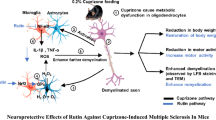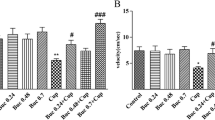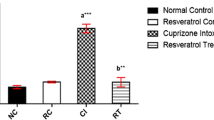Abstract
Multiple Sclerosis (MS) is a chronic, progressive demyelinating disease of the central nervous system that causes the most disability in young people, besides trauma. Coenzyme Q10 (CoQ10)—also known as ubiquinone—is an endogenous lipid-soluble antioxidant in the mitochondrial oxidative respiratory chain which can reduce oxidative stress and inflammation, the processes associated with demyelination in MS. Cuprizone (CPZ) intoxication is a well-established model of inducing MS, best for studying demyelination—remyelination. In this study, we examined for the first time the role of CoQ10 in preventing demyelination and induction of remyelination in the chronic CPZ model of MS. 40 male mice were divided into four groups. 3 group chewed CPZ-containing food for 12 weeks to induce MS. After 4 weeks, one group were treated with CoQ10 (150 mg/kg/day) by daily gavage until the end of the experiment, while CPZ poisoning continued. At the end of 12 weeks, tail suspension test (TST) and open field test (OFT) was taken and animals were sacrificed to assess myelin basic protein (MBP), oligodendrocyte transcription factor-1 (Olig1), tumor necrosis factor-α (TNF-α) and interleukin 6 (IL-6) by real-time polymerase chain reaction (real-time PCR) and total antioxidant capacity (TAC) and superoxide dismutase (SOD) by Elisa test. Luxol fast blue (LFB) staining was used to evaluate histological changes. CoQ10 administration promoted remyelination in histological findings. MBP and Olig-1 expression were increased significantly in CoQ10 treated group compare to the CPZ-intoxicated group. CoQ10 treatment alleviated stress oxidative status induced by CPZ and dramatically suppress inflammatory biomarkers. CPZ ingestion made no significant difference between normal control group and the CPZ-intoxicated group in TST and OFT. CoQ10 can enhance remyelination in the CPZ model and potentially might have same effects in MS patients.





Similar content being viewed by others
References
Akassoglou K, Bauer J, Kassiotis G, Pasparakis M, Lassmann H, Kollias G, Probert L (1998) Oligodendrocyte apoptosis and primary demyelination induced by local TNF/p55TNF receptor signaling in the central nervous system of transgenic mice: models for multiple sclerosis with primary oligodendrogliopathy. Am J Pathol 153(3):801–813
Berghoff SA, Düking T, Spieth L, Winchenbach J, Stumpf SK, Gerndt N, Saher G (2017) Blood-brain barrier hyperpermeability precedes demyelination in the cuprizone model. Acta Neuropathol Commun 5(1):94
Boggs J (2006) Myelin basic protein: a multifunctional protein. Cell Mol Life Sci CMLS 63(17):1945–1961
Bölcskei K, Kriszta G, Sághy É, Payrits M, Sipos É, Vranesics A, Komoly S (2018) Behavioural alterations and morphological changes are attenuated by the lack of TRPA1 receptors in the cuprizone-induced demyelination model in mice. J Neuroimmunol 320:1–10
Boyd A, Zhang H, Williams A (2013) Insufficient OPC migration into demyelinated lesions is a cause of poor remyelination in MS and mouse models. Acta Neuropathol 125(6):841–859
Crane FL (2001) Biochemical functions of coenzyme Q10. J Am Coll Nutr 20(6):591–598
Dahri M, Tarighat-Esfanjani A, Asghari-Jafarabadi M, Hashemilar M (2019) Oral coenzyme Q10 supplementation in patients with migraine: effects on clinical features and inflammatory markers. Nutr Neurosci 22(9):607–615
Dendrou CA, Fugger L, Friese MA (2015) Immunopathology of multiple sclerosis. Nat Rev Immunol 15(9):545–558
Doll S, Freitas FP, Shah R, Aldrovandi M, da Silva MC, Ingold I et al (2019) FSP1 is a glutathione-independent ferroptosis suppressor. Nature 575:693–698
Dutta R, McDonough J, Yin X, Peterson J, Chang A, Torres T, Fox RJ (2006) Mitochondrial dysfunction as a cause of axonal degeneration in multiple sclerosis patients. Ann Neurol 59(3):478–489
Frid K, Einstein O, Friedman-Levi Y, Binyamin O, Ben-Hur T, Gabizon R (2015) Aggregation of MBP in chronic demyelination. Ann Clin Transl Neurol 2(7):711–721
Frischer JM, Bramow S, Dal-Bianco A, Lucchinetti CF, Rauschka H, Schmidbauer M, Lassmann H (2009) The relation between inflammation and neurodegeneration in multiple sclerosis brains. Brain 132(5):1175–1189
Ghaiad HR, Nooh MM, El-Sawalhi MM, Shaheen AA (2017) Resveratrol promotes remyelination in cuprizone model of multiple sclerosis: biochemical and histological study. Mol Neurobiol 54(5):3219–3229
Gilgun-Sherki Y, Melamed E, Offen D (2004) The role of oxidative stress in the pathogenesis of multiple sclerosis: the need for effective antioxidant therapy. J Neurol 251(3):261–268
Hernández-Camacho JD, Bernier M, López-Lluch G, Navas P (2018) Coenzyme Q10 supplementation in aging and disease. Front Physiol 9:44
Jhelum P, Santos-Nogueira E, Teo W, Haumont A, Lenoël I, Stys PK, David S (2020) Ferroptosis mediates cuprizone-induced loss of oligodendrocytes and demyelination. J Neurosci. https://doi.org/10.1523/JNEUROSCI.1749-20.2020
Kamzalov S, Sumien N, Forster MJ, Sohal RS (2003) Coenzyme Q intake elevates the mitochondrial and tissue levels of coenzyme Q and α-tocopherol in young mice. J Nutr 133(10):3175–3180
Kashani IR, Chavoshi H, Pasbakhsh P, Hassani M, Omidi A, Mahmoudi R, Zendedel A (2017) Protective effects of erythropoietin against cuprizone-induced oxidative stress and demyelination in the mouse corpus callosum. Iran J Basic Med Sci 20(8):886
Kipp M, Clarner T, Dang J, Copray S, Beyer C (2009) The cuprizone animal model: new insights into an old story. Acta Neuropathol 118(6):723–736
Kondo MA, Fukudome D, Smith DR, Gallagher M, Kamiya A, Sawa A (2016) Dimensional assessment of behavioral changes in the cuprizone short-term exposure model for psychosis. Neurosci Res 107:70–74
Kumar A, Kaur H, Devi P, Mohan V (2009) Role of coenzyme Q10 (CoQ10) in cardiac disease, hypertension and Meniere-like syndrome. Pharmacol Ther 124(3):259–268
Kwong LK, Kamzalov S, Rebrin I, Bayne A-CV, Jana CK, Morris P, Sohal RS (2002) Effects of coenzyme Q10 administration on its tissue concentrations, mitochondrial oxidant generation, and oxidative stress in the rat. Free Radical Biol Med 33(5):627–638
Lassmann H (2013) Pathology and disease mechanisms in different stages of multiple sclerosis. J Neurol Sci 333(1–2):1–4
Li Z, He Y, Fan S, Sun B (2015) Clemastine rescues behavioral changes and enhances remyelination in the cuprizone mouse model of demyelination. Neurosci Bull 31(5):617–625
Linares D, Taconis M, Mana P, Correcha M, Fordham S, Staykova M, Willenborg DO (2006) Neuronal nitric oxide synthase plays a key role in CNS demyelination. J Neurosci 26(49):12672–12681
Lindner M, Heine S, Haastert K, Garde N, Fokuhl J, Linsmeier F, Stangel M (2008) Sequential myelin protein expression during remyelination reveals fast and efficient repair after central nervous system demyelination. Neuropathol Appl Neurobiol 34(1):105–114
Liu Q, Lv H-W, Yang S, He Y-Q, Ma Q-R, Liu J (2020) NEP1-40 alleviates behavioral phenotypes and promote oligodendrocyte progenitor cell differentiation in the hippocampus of cuprizone-induced demyelination mouse model. Neurosci Lett. https://doi.org/10.1016/j.neulet.2020.134872
Lucchinetti C, Brück W, Parisi J, Scheithauer B, Rodriguez M, Lassmann H (2000) Heterogeneity of multiple sclerosis lesions: implications for the pathogenesis of demyelination. Ann Neurol 47(6):707–717
Maes M, Yirmyia R, Noraberg J, Brene S, Hibbeln J, Perini G, Maj M (2009) The inflammatory & neurodegenerative (I&ND) hypothesis of depression: leads for future research and new drug developments in depression. Metab Brain Dis 24(1):27–53
Mao P, Reddy PH (2010) Is multiple sclerosis a mitochondrial disease? Biochim Biophys Acta Mol Basis Dis 1802(1):66–79
McCarthy S, Somayajulu M, Sikorska M, Borowy-Borowski H, Pandey S (2004) Paraquat induces oxidative stress and neuronal cell death; neuroprotection by water-soluble Coenzyme Q10. Toxicol Appl Pharmacol 201(1):21–31
McGarry A, McDermott M, Kieburtz K, de Blieck EA, Beal F, Marder K, Mallonee WM (2017) A randomized, double-blind, placebo-controlled trial of coenzyme Q10 in Huntington disease. Neurology 88(2):152–159
Miller E, Walczak A, Saluk J, Ponczek MB, Majsterek I (2012) Oxidative modification of patient’s plasma proteins and its role in pathogenesis of multiple sclerosis. Clin Biochem 45(1–2):26–30
Othman A, Frim DM, Polak P, Vujicic S, Arnason BG, Boullerne AI (2011) Olig1 is expressed in human oligodendrocytes during maturation and regeneration. Glia 59(6):914–926
Özenci V, Kouwenhoven M, Huang YM, Kivisäkk P, Link H (2000) Multiple sclerosis is associated with an imbalance between tumour necrosis factor-alpha (TNF-α)-and IL-10-secreting blood cells that is corrected by interferon-beta (IFN-β) treatment. Clin Exp Immunol 120(1):147–153
Pandur E, Pap R, Varga E, Jánosa G, Komoly S, Fórizs J, Sipos K (2019) Relationship of iron metabolism and short-term cuprizone treatment of C57BL/6 mice. Int J Mol Sci 20(9):2257
Papucci L, Schiavone N, Witort E, Donnini M, Lapucci A, Tempestini A, Carella G (2003) Coenzyme q10 prevents apoptosis by inhibiting mitochondrial depolarization independently of its free radical scavenging property. J Biol Chem 278(30):28220–28228
Pasquini L, Calatayud C, Una AB, Millet V, Pasquini J, Soto E (2007) The neurotoxic effect of cuprizone on oligodendrocytes depends on the presence of pro-inflammatory cytokines secreted by microglia. Neurochem Res 32(2):279–292
Plant SR, Arnett HA, Ting JPY (2005) Astroglial-derived lymphotoxin-α exacerbates inflammation and demyelination, but not remyelination. Glia 49(1):1–14
Praet J, Guglielmetti C, Berneman Z, Van der Linden A, Ponsaerts P (2014) Cellular and molecular neuropathology of the cuprizone mouse model: clinical relevance for multiple sclerosis. Neurosci Biobehav Rev 47:485–505
Rahmati-Ahmadabad S, Broom DR, Ghanbari-Niaki A, Shirvani H (2019) Effects of exercise on reverse cholesterol transport: a systemized narrative review of animal studies. Life Sci 224:139–148
Ramagopalan SV, Sadovnick AD (2011) Epidemiology of multiple sclerosis. Neurol Clin 29(2):207–217
Salehpour F, Farajdokht F, Cassano P, Sadigh-Eteghad S, Erfani M, Hamblin MR, Mahmoudi J (2019) Near-infrared photobiomodulation combined with coenzyme Q10 for depression in a mouse model of restraint stress: reduction in oxidative stress, neuroinflammation, and apoptosis. Brain Res Bull 144:213–222
Sanoobar M, Eghtesadi S, Azimi A, Khalili M, Jazayeri S, Reza Gohari M (2013) Coenzyme Q10 supplementation reduces oxidative stress and increases antioxidant enzyme activity in patients with relapsing–remitting multiple sclerosis. Int J Neurosci 123(11):776–782
Sanoobar M, Eghtesadi S, Azimi A, Khalili M, Khodadadi B, Jazayeri S, Aryaeian N (2015) Coenzyme Q10 supplementation ameliorates inflammatory markers in patients with multiple sclerosis: a double blind, placebo, controlled randomized clinical trial. Nutr Neurosci 18(4):169–176
Semnani M, Mashayekhi F, Azarnia M, Salehi Z (2017) Effects of green tea epigallocatechin-3-gallate on the proteolipid protein and oligodendrocyte transcription factor 1 messenger RNA gene expression in a mouse model of multiple sclerosis. Folia Neuropathol 55:199–205
Shults CW, Oakes D, Kieburtz K, Beal MF, Haas R, Plumb S, Carter J (2002) Effects of coenzyme Q10 in early Parkinson disease: evidence of slowing of the functional decline. Arch Neurol 59(10):1541–1550
Soleimani M, Jameie SB, Barati M, Mehdizadeh M, Kerdari M (2014) Effects of coenzyme Q10 on the ratio of TH1/TH2 in experimental autoimmune encephalomyelitis model of multiple sclerosis in C57BL/6. Iran Biomed J 18(4):203
Spooren A, Kolmus K, Laureys G, Clinckers R, De Keyser J, Haegeman G, Gerlo S (2011) Interleukin-6, a mental cytokine. Brain Res Rev 67(1–2):157–183
Steru L, Chermat R, Thierry B, Simon P (1985) The tail suspension test: a new method for screening antidepressants in mice. Psychopharmacology 85(3):367–370
Torkildsen Ø, Brunborg L, Myhr KM, Bø L (2008) The cuprizone model for demyelination. Acta Neurol Scand 117:72–76
Varela-López A, Giampieri F, Battino M, Quiles JL (2016) Coenzyme Q and its role in the dietary therapy against aging. Molecules 21(3):373
Voß EV, Škuljec J, Gudi V, Skripuletz T, Pul R, Trebst C, Stangel M (2012) Characterisation of microglia during de-and remyelination: can they create a repair promoting environment? Neurobiol Dis 45(1):519–528
Wallin MT, Culpepper WJ, Nichols E, Bhutta ZA, Gebrehiwot TT, Hay SI, Naghavi M (2019) Global, regional, and national burden of multiple sclerosis 1990–2016: a systematic analysis for the Global Burden of Disease Study 2016. Lancet Neurol 18(3):269–285
Yang X, Dai G, Li G, Yang ES (2010) Coenzyme Q10 reduces β-amyloid plaque in an APP/PS1 transgenic mouse model of Alzheimer’s disease. J Mol Neurosci 41(1):110–113
Zahednasab H, Firouzi M, Kaboudanian-Ardestani S, Mojallal-Tabatabaei Z, Karampour S, Keyvani H (2019) The protective effect of rifampicin on behavioral deficits, biochemical, and neuropathological changes in a cuprizone model of demyelination. Cytokine 113:417–426
Zendedel A, Beyer C, Kipp M (2013) Cuprizone-induced demyelination as a tool to study remyelination and axonal protection. J Mol Neurosci 51(2):567–572
Zhang Y, Bi X, Adebiyi O, Wang J, Mooshekhian A, Cohen J et al (2019) Venlafaxine improves the cognitive impairment and depression-like behaviors in a cuprizone mouse model by alleviating demyelination and neuroinflammation in the brain. Front Pharmacol. https://doi.org/10.3389/fphar.2019.00332
Acknowledgements
The authors would like to express their gratitude to the School of Medicine, AJA University of Medical Sciences, Tehran, Iran for their support.
Funding
Authors confrm that they did not receive any fund to do this work.
Author information
Authors and Affiliations
Corresponding author
Ethics declarations
Conflict of interest
The authors declare no conflicts of interest.
Additional information
Publisher's Note
Springer Nature remains neutral with regard to jurisdictional claims in published maps and institutional affiliations.
Rights and permissions
About this article
Cite this article
Khalilian, B., Madadi, S., Fattahi, N. et al. Coenzyme Q10 enhances remyelination and regulate inflammation effects of cuprizone in corpus callosum of chronic model of multiple sclerosis. J Mol Histol 52, 125–134 (2021). https://doi.org/10.1007/s10735-020-09929-x
Received:
Accepted:
Published:
Issue Date:
DOI: https://doi.org/10.1007/s10735-020-09929-x




